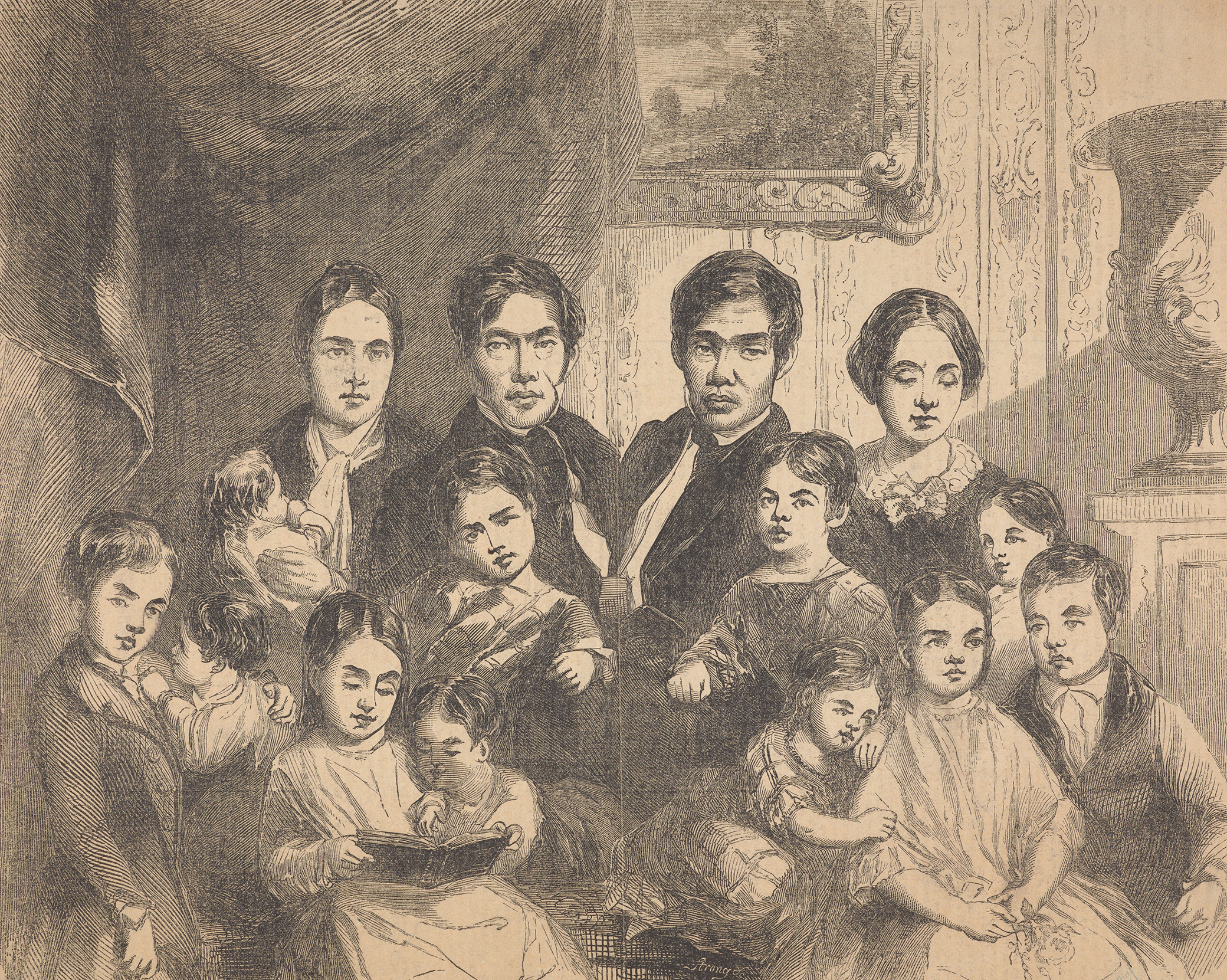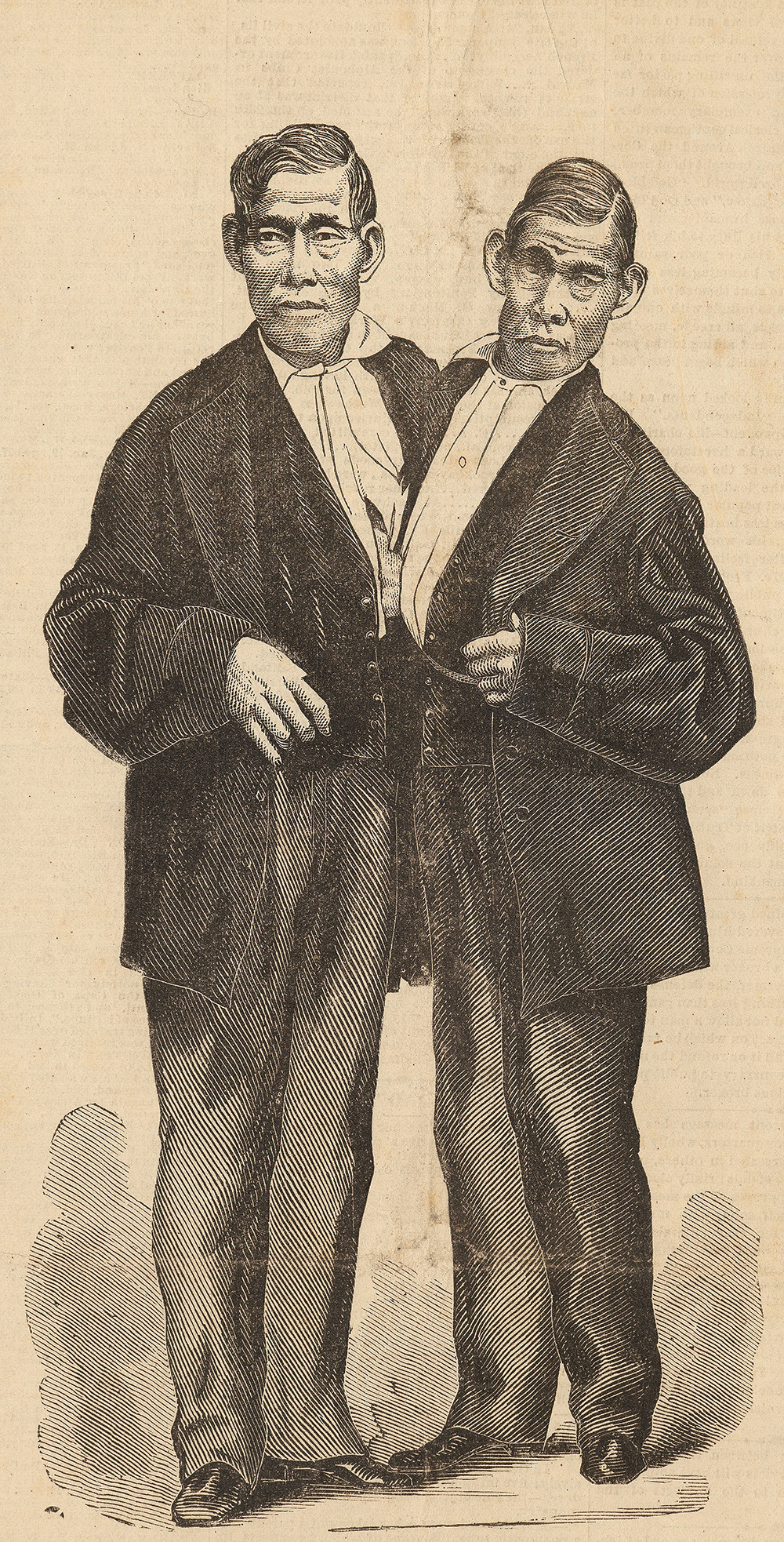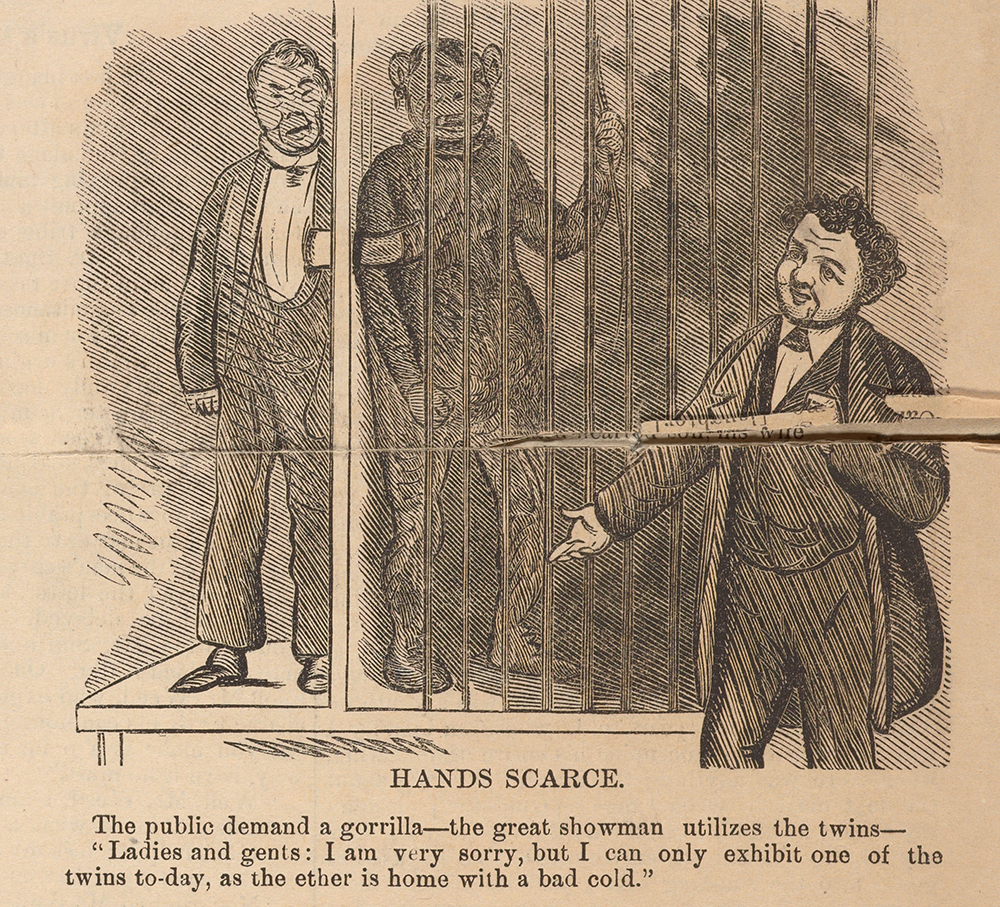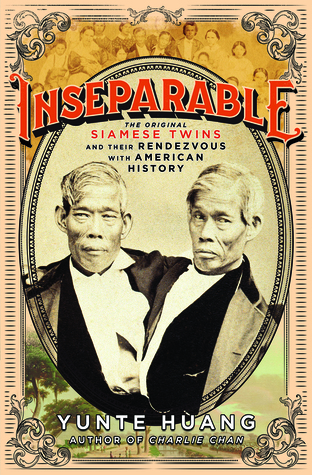
“A Characteristic Group, Representing Chang and Eng, the Siamese Twins, with Their Wives and Children,” c. 1850. The New York Public Library, The Miriam and Ira D. Wallach Division of Art, Prints and Photographs.
Curiously, the debut of the Siamese Twins, Chang and Eng Bunker, in America was held at a ruined site. The Exchange Coffee House, a seven-story building clad in hammered granite and brick, had once been the pride of Boston. Funded by local financiers who had profited from the booming China trade, the building was completed in 1809. One of the largest and most imposing structures in the nation at the time it was built, the Exchange Coffee House combined a hotel, a café, and a public exchange. It boasted a giant dome, a portico of six Ionic columns, a spiral stairway, and about a hundred bedrooms scattered throughout the top floors. With a staggering construction cost of more than half a million dollars, this proud symbol of Boston’s affluence and optimism had been the center of activities for about a decade until it burned to the ground in a spectacular fire on the evening of November 3, 1818. When the giant dome collapsed, the flames shot so high into the night sky that they were visible distinctly from sixty miles away. Never to be rebuilt, the Exchange Coffee House had remained a ruined site, often compared to the Capitol in Washington after its destruction by the British army during the War of 1812. It would now provide the backdrop for the first display of the conjoined twins.
In the last week of August 1829, thousands of Bostonians, lured by a blizzard of publicity via newspaper reports, advertisements, handbills, and eye-catching posters, stood in long queues outside the tent at the Exchange, eager to get a peek at the curiosity from afar. Each of them would pay a stiff fifty-cent admission fee. In the promotional brochure for sale at ten cents, Bostonians saw an exotic scene:
An image of the young Chang and Eng presents them clad in pantaloons and tunics with ornate brocade. Their complexions are swarthy, even dark, and their slanted eyes and bulbous foreheads make them appear inextricably foreign. They stand against a backdrop that suggests a comfortable coexistence with what is presumed their natural habitat. Lush tropical vegetation graces the foreground. Behind them are palm trees and huts. Farther in the distance is domed architecture evocative of North Africa and West Asia, collapsing multiple Orients into one another.
The twins in person did, in fact, shock the senses of the viewers, who thought they saw a monster. In the words of an Ohio visitor who later wrote about his experience, “The famous Siamese boys presented a sight, I admit, at first view a little revolting.” In fact, if the printer designing the poster had gotten his way, the headline would have been more provocative—“The Monster.” But the owners objected, and the billing was later changed to a more benign “The Siamese Double Boys.” Still, the “monster” idea certainly hovered in the minds of the crowds flocking into the tent. Mary Shelley’s Frankenstein, first published in 1818, had been a hit in Boston. In 1755, the famous Swedish botanist Carl Linnaeus had already drawn a distinction among Homo sapiens, Homo monstrosus (monster man), and Homo ferus (wild man). According to Linnaeus and his followers, there was a descending hierarchy, a pecking order of sorts, which made up a “great chain of being.” In On the Origin of Species, which appeared a few decades later, Charles Darwin would also suggest the existence of Homo monstrosus as a product of crossbreeding between Homo sapiens and other species in the great scheme of evolution.

Science aside, the idea of a human monster, or freak, had had a long-lasting appeal in the popular imagination ever since Aristotle deemed a freak a lusus naturae, an aberration of the Natural Ladder. As Leslie Fiedler puts it in his trailblazing 1978 study, Freaks, “The myth of monsters is twice-born in the psyche.” Fiedler believed that while the concept of the monster originates in the deep fears of our childhood, it is reinforced in adolescence by the young adult’s awareness of his or her own sex and that of others. In the case of a young male, “his penis disconcertingly continues to rise and fall, swell and shrink—at times an imperious giant, at others a timid dwarf.” For girls at puberty, the growth of breasts is also traumatic. “It is a rare young woman who in the crisis of adolescent shamefacedness does not feel herself either too flat-chested or too generously endowed, and in either case a Freak.” In other words, it is our own secret fear or self-image that draws us toward human anomalies on display. As Robert Bogdan maintains in a more recent study, “Dwarfs, for example, confront us with our phobia that we will never grow up.” Bogdan emphasizes that the term monster or freak “is not a quality that belongs to the person on display. It is something that we created: a perspective, a set of practices—a social construction.”
To construct such a perspective, to tantalize the audience’s deep psychic complex without turning them off, was a delicate balancing act, a lucrative art that P.T. Barnum and his ilk would practice to perfection in the coming decades. A widely publicized report on the twins ended with a reassurance to the viewing public: “Let me add that there is nothing unpleasant in the aspect of these boys. On the contrary, they must be viewed as presenting one of the most interesting objects of natural history, which have ever been known to scientific men.” According to the Boston Bulletin, the twins “are taught no tricks to enhance the foolish part of an exhibition, but are allowed to conduct as they please, naturally and easily, according to the momentary dictates of their feelings.” Their exotic and abnormal appearance was shocking enough, and letting the twins act like a “normal” human being further intensified the sense of the uncanny: The monster is just like us, and yet so different.

After their sensational debut in Boston, the twins were then taken to Providence, only fifty miles to the south. New to the country and still struggling with the English language—newspapers reported that the twins would “master three or four English words every day”—they knew little about American geography. Traveling in an enclosed carriage, the twins arrived in Providence, a city of about seventeen thousand people, where they were greeted by thousands of curious gawkers. By this time, the twins had added new routines—somersaults in tandem, quick backflips, and occasional challenges to members of the audience for a game of checkers or chess. Once, to amuse the spectators, the twins, weighing together no more than two hundred pounds, carried a 280-pound man around the exhibition hall.
Barely a month into their debut, the twins had already provoked intense debates over matters of religion, soul, and individuality. The fact that they were simultaneously two and one had provided not only a rare specimen for the medical professionals but also ample food for thought for theologians, philosophers, and amateur thinkers. On the last day of the twins’ exhibition in Boston, an article appeared in a local newspaper posing a series of “knotty questions.” Playing on the Shakespearean line “Double, double, toil and trouble,” the author asked: What would happen if one brother converted to Christianity while the other remained a disciple “of the great Buddha”? “Would both souls be saved since one twin was a ‘heathen’?”

These questions about soul and salvation recalled a much earlier incident, in the sixteenth century, when an autopsy—supposedly the first by white men in the Americas—had been performed in 1533 after the birth of two conjoined sisters on the island of Hispaniola. The priest performing the baptism was, in fact, befuddled by the question of whether the girls had one soul or two. When the twins died eight days later, an autopsy was conducted, and, based on the findings, the girls were deemed as possessing two separate souls. Given such a precedent, it was taken for granted that Chang and Eng had two separate souls, but the question of salvation remained. Moreover, the Boston author went on to ask: What if one of them committed a crime? “Would ye indict two men as an individual? Dare ye send Chang and his brother to jail when only Chang shall happen to break the peace? Or, if Chang and Eng should fall out together, tell us, we beseech ye, could Chang have his action for being assaulted by his other half, that is by himself?”
Not everyone, however, thought the twins were worthy of the unusual attention they were getting. On September 15, the Rhode Island American published an article by a David B. Slack, dismissing the brouhaha. “The world has profited but little by wonders of any kind, either in story or in fact,” wrote the author, who insisted that the conjoined twins, as tricks of nature, were “sources of amusement that depressed and weakened the mind, not models for enlightenment.” As such, Slack concluded, these boys “held no more significance for human society than did a double-yolked egg.”
Excerpted from Inseparable: The Original Siamese Twins and Their Rendezvous with American History by Yunte Huang. © 2018 by Yunte Huang. Used with permission of the publisher, Liveright Publishing Corporation, a division of W.W. Norton & Company, Inc. All rights reserved.
